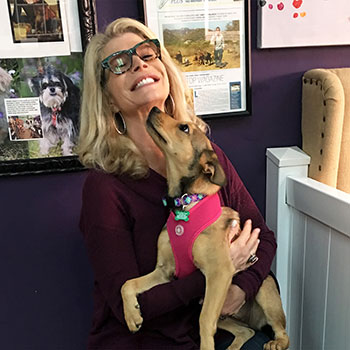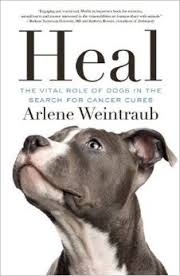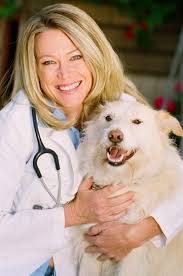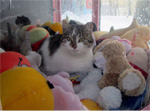Genius Idea For Shelter Pets
Kim Sill, Shelter Hope Pet Shop
 Actress Kim Sill is back to tell us about her adoption project. She put an adoption store inside a mall. Kim is saving hundreds of death row cats, dogs and bunnies by changing their adoption venue to the more appealing atmosphere.
Actress Kim Sill is back to tell us about her adoption project. She put an adoption store inside a mall. Kim is saving hundreds of death row cats, dogs and bunnies by changing their adoption venue to the more appealing atmosphere.
Shelter Hope Pet Shop, located in a shopping mall, provides a fun, friendly place where visitors and volunteers can meet and interact with animals needing adoption. You can also visit Shelter Hope Pet Shops for pet merchandise and know your dollars are going directly back to help save the lives of homeless pets.
The dogs in the Shelter Hope Pet Shop in Thousand Oaks, California, primarily come from the Los Angeles area. The purpose of Shelter Hope Pet Shop is to help animals get shown, as a lot of people don't like to visit shelters, because it is a sad place. The animals are then moved into malls, where people might be going to see a movie, they're happy and shopping, and then all of a sudden they come across a cute dog staring at them from a window and they have to go in and see them.
If you do decide to adopt one of these dogs, you will go home with everything you need, including a kennel, harness, leash, tag and a microchip. You will also receive the bedding that the dog has become familiar with, food, treats and toys. They will also give you a free vet visit as well as a free doggy daycare and a free training session with a trainer as well as a free grooming. Kim states that they do this because they want people to understand what it's like to own a dog and that it comes with responsibilities.
 If you are not in a position to adopt a dog, there are other things you can do to help, such as becoming a foster or a driver to transport them. You can also donate supplies such as dog beds and even printer ink. You can find a list of items on their website that they are desperately in need of, because they don't want to spend their money on these items, they want to save their money for the shelter dogs to get them out and even to spay or neuter them.
If you are not in a position to adopt a dog, there are other things you can do to help, such as becoming a foster or a driver to transport them. You can also donate supplies such as dog beds and even printer ink. You can find a list of items on their website that they are desperately in need of, because they don't want to spend their money on these items, they want to save their money for the shelter dogs to get them out and even to spay or neuter them.
So what happens to the dogs if they don't get adopted right away? Kim says they partner with boarding facilities and the dogs do not stay at the mall overnight. They also have foster homes and people willing to drive the animals to a foster home or a boarding facility, so that all of the dogs get to go home to a warm, comfy bed.
Shelter Hope Pet Shops also give back to the community by providing free microchipping and free vaccinations.
Visit Website
The Vital Role of Dogs in the Search for Cancer Cures
Arlene Weintraub, HEAL
 We love our dogs. They sleep with us. They cuddle with us. They give us unconditional love. But, they are doing even more. They are helping scientists discover many new ways to cure cancer. Doctors and veterinarians are working together to develop new cancer treatments.
We love our dogs. They sleep with us. They cuddle with us. They give us unconditional love. But, they are doing even more. They are helping scientists discover many new ways to cure cancer. Doctors and veterinarians are working together to develop new cancer treatments.
Arlene Weintraub is a veteran health and science writer and has a book out called, HEAL: The Vital role of Dogs in the search for Cancer Cures. Drawn from extensive research, on-the-ground reporting and personal experience, her book explores the fascinating role dogs are playing in the search for a cure for cancer.
You will find many different ways that dogs are helping in the fight against cancer in her book. Most people don't know that dogs develop many of the same types of cancer that humans do including breast cancer, lymphoma, osteosarcoma and gastric cancer. Dogs are now being recruited into clinical trials for new therapies that could end up helping both pets and people with cancer.
Some types of tumors in pets and people are so similar that scientists can't tell the difference when looking at them under a microscope. Melanoma is a good example. Dogs gets exactly the same melanoma that people get and have been very important in helping scientists make new discoveries.
Cats are also involved in this field of research, which is called comparative oncology. Cats actually get a form of breast cancer, or mammary cancer, which is very similar to triple negative breast cancer in women. This is the hardest type of breast cancer to cure. As a result, there is a growing interest in recruiting cats for breast cancer research.
Arlene tells is that cancer is a very prevalent disease in dogs, with an estimate of about 1 out of every 3 dogs dying of cancer. It is largely a disease of aging in dogs, just like in humans. However, there are some breeds that are more prone to the disease and can develop it quite young, particularly Golden Retrievers.
 Treatment for cancer in animals is pretty much the same as humans undergo, including chemotherapy and radiation. Surgery also can be quite effective in the treatment of cancer in dogs. Actually, the very first cancer drugs approved for dogs were approved in the last 10 to 15 years, so now there's an effort underway to tailor therapies for pets.
Treatment for cancer in animals is pretty much the same as humans undergo, including chemotherapy and radiation. Surgery also can be quite effective in the treatment of cancer in dogs. Actually, the very first cancer drugs approved for dogs were approved in the last 10 to 15 years, so now there's an effort underway to tailor therapies for pets.
Some companies have even started developing two drugs for cancer, one for people and one for dogs, based on the same science. In fact, Arlene mentions in her book that the first ever cancer drug approved for dogs also has a version for people too.
There is also a chapter in Arlene's book on dogs being able to sniff out cancers in humans. She states this is a very exciting branch of research and many scientists around the world have proven that they can train dogs to detect tumors. They can also train them to smell the difference between cancerous tissue and normal tissue. There is an effort underway to translate that into diagnostic device for early detection, because it wouldn't be too practical to have dogs in every hospital in the world.
Arlene wrote the book after losing her sister to gastric cancer, and takes her own personal journey from grief to healing, as she shows her readers how man's best friend might be the key to unlocking the mysteries of cancer.
Arlene feels that anyone who has either experienced cancer in a family member or their dog, will find some hope in cancer research by reading her book.
Arlene Weintraub is a veteran health and science writer who has contributed to such publications and websites as US News & World Report, Forbes.com and the New York Times, and was a staff writer for BusinessWeek for 10 years. She is also the author of Selling the Fountain of Youth.
Visit Website
TOXIC LOVE: Valentine Dangers
Doc Halligan, Lucy Pet Foundation
 While you may not associate Valentine's Day with pet dangers, Doc Halligan from the Lucy Pet Foundation thinks you should be extra cautious. She sees more animals the day after Valentines (only third after Christmas and Halloween), usually because pets swallow something they shouldn't have.
While you may not associate Valentine's Day with pet dangers, Doc Halligan from the Lucy Pet Foundation thinks you should be extra cautious. She sees more animals the day after Valentines (only third after Christmas and Halloween), usually because pets swallow something they shouldn't have.
Love is in the air and everywhere you look you will find advertisements for gifts to your Loved one. Doc Halligan doesn't want to spoil the mood but these very gifts meant to entice your sweetheart can cause your pet great harm. So here are some Valentines Safety tips to protect your "furry" loved one this Valentines Day.
Tip # One:
As surprising as it may be, pets love undergarments. The more fancy the better and especially after you've worn them. It's true, every year dogs and cats undergo extensive surgery to remove leopard or heart-printed panties and bras from cats and dogs. The problem starts after that sizzling romantic interlude where panties, bras, etc., are ripped off and thrown on the ground. Along comes Fido or Morris, who wanting to get involved in all the excitement, start playing with these TOYS and the next thing you know they have swallowed them. But when ingested, lingerie causes bowel or stomach obstructions, which can be deadly and must be surgically removed by your veterinarian. So, the points here is go ahead and have that passionate interlude but remember to pick up your undergarments before your cat or dog has time to get to them.
Tip # Two:
Not only will pets eat undergarments, but they also love things that sparkle. Diamond bracelets, rings, necklaces, etc., will often end up in your pet's stomach if you're not careful. Luckily most of these items will pass through your pet and be eliminated without too much harm to your pet or the jewelry. The only thing is that you have to search for it through, you guessed it, in your pet's stool. So a jewelry box is a good investment and if your loved one pops the question this Valentines Day, keep the diamond on your finger to avoid an engagement at the vet clinic.
Tip # Three:
 Love letters are abounding this month with fancy paper and pen. But like all paper objects, puppies, kittens, cats and dogs will chew eat and swallow through most of the best and romantic phrases to cause stomach upset and even intestinal obstructions. Most of the time pets will pass the paper and the only harm comes from the loss of some pretty romantic verse, but it is better to store your love notes, etc., in a safe place away from your four-legged friends.
Love letters are abounding this month with fancy paper and pen. But like all paper objects, puppies, kittens, cats and dogs will chew eat and swallow through most of the best and romantic phrases to cause stomach upset and even intestinal obstructions. Most of the time pets will pass the paper and the only harm comes from the loss of some pretty romantic verse, but it is better to store your love notes, etc., in a safe place away from your four-legged friends.
Tip # Four:
Planning a nice candle lit dinner for your loved one? That's great, but cats and dogs are intrigued by the dancing flames and not only will whiskers get burned but sometimes the hot wax will burn even the cutest paws and face. So just be careful and monitor the candles and try to keep them away from any curious pets in the household.
Tip # Five:
Roses are red violets are blue, watch out kitty some flowers are dangerous to chew! That's right certain plants and flowers are toxic to your pets. And the freshness packets that come with some floral arrangements seem quite interesting and even tasty to your cat and dog causing serious stomach upset. The best thing is to keep all of your beautiful floral arrangements away from your pets by placing them up high where your pets can't taste them. Remember anything new in the household is up for examination and scrutiny by your curious furry loved one.
Tip # Six:
Chocolate is the food for lovers but it is very toxic to dogs and even a small amount can cause serious consequences and even death. Those cute heart-shaped kisses can be the kiss of death for your dog because chocolate contains methylxanthine alkaloids in the form of theobromine and caffeine that causes constriction of arteries, increased heart rate and central nervous system stimulation. This can lead to vomiting, diarrhea, restlessness, increased urination and eventually cause excitability, increased respirations and heartbeat, stiffness, seizures and exaggerated reflexes. Certain types of chocolate contain higher amounts of this alkaloid; baking chocolate is the highest with white chocolate being the lowest. A potential lethal dose in a fifteen-pound dog is only one pound of milk chocolate. Cardiac failure, seizures, coma and even death can occur if the pet is not treated within four to six hours after ingestion. So be very careful with all of your Godiva chocolates and Hershey's kisses and remember to contact your vet immediately if you suspect your pet has gotten into the "sweets."
 Just remember these tips and both you and your pets can have a Happy Valentine's Day!
Just remember these tips and both you and your pets can have a Happy Valentine's Day!
The Mission of The Lucy Pet Foundation is to reduce pet overpopulation by having mobile spay/neuter clinics across the country and to support causes that benefit animal welfare. The Lucy Pet Foundation's buses travel around Southern California focusing on spaying and neutering. These buses are state of the art surgery units.
The Lucy Pet Foundation not only offers free and reduced spays and neuters, they also do microchipping, vaccines and de-wormings. Spaying and neutering is not only great for pet population control, but it has been proven that an animal will live on an average of 40-percent longer after having this surgery.
Visit Website
Don't Litter - Spay or Neuter Instead! - Dr. Debbie
 World Spay Day is February 27, 2024. Do you believe your beautiful pedigreed pooch just has to be bred, or that your cat can't possible get outside to become pregnant, or that you long to have just one litter from Fluffy? If so, listen in to the unified pet health message of Spay Day. Shelter staff, veterinarians and animal advocates all join together to encourage spaying and neutering. It's the right thing to do for your pet's health and is a step forward in addressing pet overpopulation issues. With approximately 3 million dogs and cats euthanized at U.S. shelters every year, pet owners can do their part to avoid unintended and unnecessary breeding.
World Spay Day is February 27, 2024. Do you believe your beautiful pedigreed pooch just has to be bred, or that your cat can't possible get outside to become pregnant, or that you long to have just one litter from Fluffy? If so, listen in to the unified pet health message of Spay Day. Shelter staff, veterinarians and animal advocates all join together to encourage spaying and neutering. It's the right thing to do for your pet's health and is a step forward in addressing pet overpopulation issues. With approximately 3 million dogs and cats euthanized at U.S. shelters every year, pet owners can do their part to avoid unintended and unnecessary breeding.
Your individual decisions on altering your pet do matter. Animals, left to do what they will, result in a lot of generations of whiskers and tails in just a short period of time. A pair of dogs can produce 67,000 puppies in 3 years' time. And cats in that same time frame can prosper to over 420,000 kittens.
Common Spay & Neuter Fallacies:
Isn't it better to let my female dog go into heat before I spay her?
FALSE. You can minimize the risk of breast cancer to zero by spaying before the first heat. Allow her to have a few heat cycles, and your dog has a 25-percent chance of developing breast cancer. The health benefits for females also include preventing uterine cancer and the life-threatening reproductive infection, pyometra.
Isn't it better to let a female dog have at least one litter of pups?
FALSE. There is no psychological or health benefit in allowing a female dog to have a litter. It does not make her a better, more affectionate pet. On the contrary, some pregnant female dogs are quite protective and aggressive to anyone disturbing her brood.
My dog is a purebred dog with a pedigree so it is meant to be bred.
FALSE. Having purebred papers doesn't mean an animal has to be bred. There is no shortage of purebred animals, with purebred dogs accounting for 30-percent of all animals currently in shelters.
It's a great experience to allow children to witness the beauty of birth by letting your pet have a litter.
STOP. What really is beautiful is to impart children with a sense of value toward animal life. Yes, birth is a miracle to behold. But there are many books and videos that demonstrate birth in a responsible manner, without unnecessary pet breeding.
Teach your children to care for your existing pets, from puppy hood or kitten hood until senior pet years. Children learn responsibility while caring for a pet and develop an appreciation for the human-animal bond by living it daily.
 Won't spaying or neutering my pet make my pet fat?
Won't spaying or neutering my pet make my pet fat?
FALSE. You directly control what, when and how much your pet eats. The fate of your pet's waistline lies in your hands. Your pet's metabolism may slow down some after spaying or neutering, but with sensible feeding and regular exercise you can maintain a healthy weight for your pet.
It's expensive to spay or neuter my pet.
FALSE. There are many affordable solutions to ensuring your pet is spayed or neutered. Some veterinary hospitals and shelters offer special programs on Spay Day. And other facilities offer year round low-cost options.
Still not convinced spaying & neutering is worth it? Consider that the cost of spay or neuter is less than the cost of raising kittens or pups for a year. And don't ignore the possible realities of pregnancy problems. An emergency C-section for a pet having labor difficulties costs $1000 or more.
I want my dog to guard the house. Won't spaying or neutering make my pet less protective?
FALSE. There is no relation between your pet having reproductive organs and performing as a guard dog. A dog's protective behavior is based on instinct and training. Surgically spaying or neutering doesn't change your pet's devotion to protect home and family members. And once a dog is spayed or neutered, it has less desire to roam away from home to find a mate.
Take action now.
Of course you want to do what's best for your pet. Life is busy with family demands, work and a stream of errands. But don't delay this important step to keep your pet healthy for a lifetime together with you.
For more information on Spay Day visit the Humane Society.
Featured veterinarian known as "Dr. Debbie" on national pet radio program, Animal Radio. Ebook author of "Yorkshire Terriers: How to Be Your Dog's Best Friend"; "Pugs: How to Be Your Dog's Best Friend"; "Mini Schnauzers: How to Be Your Dog's Best Friend"; and "Shih Tzu: How to Be Your Dog's Best Friend." Dr. Debbie's books.
Visit Website
 Animal Radio News - Lori Brooks
Animal Radio News - Lori Brooks
It's Tough Finding A Rental That Accepts Pets in Los Angeles
Have you ever searched for a home or apartment to rent that allowed you to have pets? It's nearly impossible to find in Los Angeles where 62-percent of the rental units do not accept pets. However, the LA City Council voted to make some changes in hopes of making landlords more open to accepting pets at their properties, with the eventual goal of reducing the number of animals who live in shelters. There are programs to make tenants more aware of their rights to own animals in rental properties, while also keeping the potential damage concerns of landlords in view. The goal is to reduce the number of animals living in "kill" shelters dramatically enough that Los Angeles can eventually consider itself a "No-Kill" city. Check out this amazing comparison: Where around 75-percent of Los Angeles rental properties refuse animals completely, 75-percent of Denver properties accept pets.
 Retired Police Dog Was Set to Be Auctioned Off
Retired Police Dog Was Set to Be Auctioned Off
When an Ohio police officer retired after 34 years of service, he assumed his police dog would be retiring with him. However, because of a state law that requires what is considered surplus state property purchased with tax payer dollars and valued at over $1,000, K9 officer Ajax was to be auctioned off to the highest bidder. Ajax had been appraised at $3,500 since he was young and still had some working years left. As you would expect, the human officer and the animal loving public was furious. A Go-Fund-Me page was then started to raise money for the retired officer to enter a bid for Ajax. It raised over $70,000. But after more research, it was concluded the canine unit was "disbanded," a distinction that meant the officer could buy Ajax for $1 under state law. Extra funds were given to an organization that provides bullet/stab proof vests to K9 units since there had been a spike in K9 officers being killed in the line of duty.
 15-Year-Old, Three-Legged Dog Saves Family - Twice
15-Year-Old, Three-Legged Dog Saves Family - Twice
A small, 15-year-old, three-legged dog might not seem like much of a threat, but this dog took a bullet for his family and saved them from a man who had broken into their home and attempted to rob them. The small dog came to the rescue when the robber kept asking, "Where's the safe? Where's the money?" and the dog, who is usually friendly with strangers, started growling at the robber. A bullet grazed the top of the dog's head and became lodged in his neck. This wasn't the first time the dog had seen police officers and emergency medical responders. About five years ago, he was dognapped in the middle of the day. Thankfully, a neighbor saw him being enticed into a van and took down the license plate number. Police found it and saved him that same day. Then, 2 years ago, he was with his family walking along some steep trails when he tumbled over the side of a cliff. His owner firmly believes his falling prevented her sons from inadvertently plunging off the cliff. That horrific incident shattered the bones in his right front leg, causing amputation to be necessary.
 What's The Story About White Cats With Blue Eyes - Are They Blind or Deaf?
What's The Story About White Cats With Blue Eyes - Are They Blind or Deaf?
Because of constant confusion, the Veterinary College at Cornell University wanted to set the record straight on pure white cats with blue eyes. Seems many people think white cats are blind or are more likely to go blind. That's NOT the case. Those cats are more likely to be deaf. Here are the facts. Not all white cats with blue eyes are born deaf, but most of them are, according to research, which has shown that 65 to 85-percent of pure white cats with two blue eyes are hearing impaired. That drops to 40-percent if the cat has one blue eye and 17 to 22-percent if the cat is pure white but does not have blue eyes. Deaf cats are happy and healthy, but should be kept indoors and kept out of situations where their safety depends upon their ability to pick up auditory cues.
 Cat Climbs Into Claw Game Machine To Stay Warm
Cat Climbs Into Claw Game Machine To Stay Warm
Most cats hate the winter weather as much as we do; so one cat in Serbia decided to take action. He found his way into the warmth of a stuffed animal "claw game" vending machine to escape the 2 degrees below zero temperatures. The cat was quite content with his warm, comfy bed until police and fire crews were able to get him safely out of the machine. If you want to help wild cats better cope with cold temperatures you can provide a shelter using a Styrofoam ice chest inside of a large plastic tote storage container. Cut a hole in one or both sides and line the tote straw, which retains warmth. Both the straw and Styrofoam act as insulation trapping warm air between layers.
 Listen to the entire Podcast of this show (#1262)
Listen to the entire Podcast of this show (#1262)





